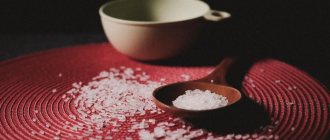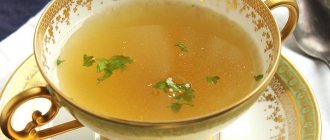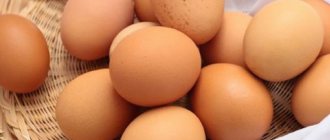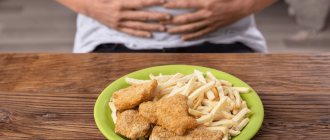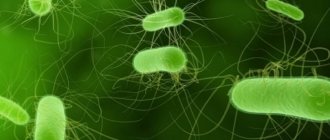Probably, almost every parent has encountered the problem of food poisoning in a child of younger and middle age. Nausea, vomiting, diarrhea, high fever, lack of appetite and weakness - as a rule, evidence of food poisoning is the appearance of these symptoms.
For a quick recovery and restoration of the baby’s body, it is necessary not only to follow the doctor’s instructions regarding taking any medications, but also to pay attention to the child’s nutrition. What can you feed a child after poisoning, how to properly prepare drinks and dishes, what foods should be limited or completely excluded from the diet, how to improve the condition of the affected intestinal microflora - we will consider these and other questions in more detail.
A gentle, balanced diet is an important tool for helping the body recover after food poisoning.
Features of gentle nutrition
To restore water-salt balance, it is recommended to offer the child as much liquid as possible.
The first question that worries every parent when identifying symptoms of food intoxication in a child is as follows: is it possible to feed a child if he is poisoned?
As a rule, in the first hours after the appearance of characteristic signs, babies suffer from a lack of appetite, and therefore there is no need for feeding. In accordance with medical standards, it is recommended to provide the child with food rest and completely avoid eating for at least six hours after poisoning.
In the future, you should adhere to the following recommendations:
- After providing the child with first aid, which consists of washing the stomach and taking medications prescribed by the attending physician, the baby should be given more fluid. This measure will help restore the disturbed water-salt balance.
- If a child refuses to drink clean water, it is permissible to give him dried fruit compote, fresh fruit juice diluted with water, or homemade fruit juice.
- You should drink in small portions, but often enough - at least once every fifteen minutes.
- You should only offer food to your child if he feels hungry. If a very small child has been poisoned, it is permissible to give the first portions of food after six hours.
Don't force your baby to eat if he doesn't want to.
Regardless of the age of the child and the degree of poisoning, you should definitely consult a doctor to make an appropriate diagnosis and obtain medical prescriptions. Self-medication without first consulting a specialist can cause harm.
Advice! If a child has diseases of the digestive tract, a suitable diet and diet should be developed in accordance with the instructions of the attending physician.
Signs of poisoning
You can determine that a child has been poisoned by the following signs: the baby’s well-being worsens - he becomes weak, capricious, lethargic, complains of abdominal pain, tightens his legs; Nausea and vomiting subsequently appear. In the case of food poisoning, vomiting may be followed by a rise in temperature and diarrhea. The development of symptoms, the severity of the disease and treatment tactics completely depend on what pathogen has entered the body.
In the case of food poisoning, a child may develop a serious condition caused by dehydration - a large loss of fluid through feces and vomit. Children who, after gastric lavage, continue to have nausea, vomiting, stool disorders, or have signs of dehydration and mild or moderate intoxication, are prescribed oral rehydration (rehydration - replenishment of lost fluid) and detoxification (aimed at removing toxins from the body - for example, taking enterosorbents) therapy , which is currently recommended for use before hospitalization.
Baby's nutrition on the first day
In the first day after poisoning, the child should be offered enveloping foods, for example, porridge and jelly.
On the first day after the diagnosis of food poisoning, special attention should be paid to the child’s nutrition and eating habits. The first portion of food should be offered only when a feeling of hunger appears; it is not recommended to feed a baby who has no appetite at all.
In general, recommendations regarding the first day of poisoning are as follows:
- For the first meal, you should offer boiled rice or buckwheat porridge cooked in water. You can also use jelly without sugar or preservatives.
- Regardless of the child’s age, in the first two days it is advisable to grind cooked food using a blender. This will help to significantly reduce the load on the stomach and improve the condition of the microflora.
- Subsequently, it is permissible to feed the child food that has been previously cut into small pieces.
- On the first day, you can drink vegetable broths, after adding a few pieces of white bread to them.
- It is not recommended to add salt, spices or seasonings to cooked dishes.
- On the first day, you should offer your child food in small portions; it is not recommended to overload the stomach. It's better to eat several small portions throughout the day.
The cost of not following the above recommendations can be quite high. Poor nutrition, non-compliance with the diet, and consumption of foods from the list of prohibited foods can lead to the development of diseases of the digestive tract.
Causes
To protect your child from intestinal infections, you need to know the main causes of poisoning. Toxic elements can enter the body through the skin, respiratory tract and digestive system.
Main causes of poisoning:
- Penetration of pathogenic organisms that release substances dangerous to the child, which lead to severe intoxication.
- Overdose of toxic chemicals or medications.
- Eating poisonous berries or mushrooms.
The main pathogens of poisoning:
- Salmonella. Causes "dirty hands" disease with high fever, severe stomach upset and vomiting;
- Staphylococcus. It enters the children's body along with unwashed foods. The disease develops rapidly;
- Streptococcus. Diagnosed in childhood in rare cases;
- Fungi and Enterococci. Retains in the body of a child with a weakened immune system.
Low-quality, spoiled or exotic products also cause poisoning. Do not give children unfamiliar exotic fruits and seafood. The child’s digestive tract reacts negatively to unfamiliar compounds, causing acute intoxication.
Diet with acetone - video
Subsequent nutrition for the child
After the first day after food poisoning, you can slightly expand the child’s diet, but it is still worth observing such principles as preliminary grinding of food, small meals and drinking large amounts of liquid for at least a week. A balanced diet and a gentle diet will help quickly eliminate the effects of poisoning and normalize the child’s well-being.
List of permitted products
Porridges and boiled vegetables are ideal dishes for restoring the body after intoxication
In the first few days after food poisoning, the menu of a sick child must include dishes that have an enveloping effect. These include, for example, various porridges and jelly. Food should be predominantly viscous and liquid.
You should choose foods that are easily digestible and quite nutritious, for example:
- boiled vegetables: carrots, broccoli, cauliflower, zucchini;
- fruits: fresh bananas and pre-baked apples;
- buckwheat and rice porridges prepared from pre-ground raw materials;
- natural fermented milk products without added flavors and dyes;
- lean varieties of meat and fish.
Based on the products listed above, it is quite possible to prepare varied and tasty dishes throughout the week after food poisoning. The video in this article will help you become more familiar with the wide range of permitted dishes and products.
List of prohibited products
After poisoning, it is strictly not recommended to consume any types of sweets.
Regardless of the form, severity and cause of poisoning, for at least seven days after food intoxication, foods and dishes that are poorly digestible and create an increased load on the digestive tract should be excluded from the child’s diet.
Among them, for example, the following should be mentioned:
- any raw vegetables and fruits other than those suggested by the instructions above;
- all types of legumes and some types of cereals: millet, semolina, pearl barley, oatmeal;
- any types of bakery products;
- any sweets, you should also exclude the consumption of sugar;
- fats of animal and vegetable origin;
- whole milk;
- fatty meats and fish;
- sausages, frankfurters, sausages, smoked meats;
- fruit juices produced in industrial conditions.
Consumption of products from this list can lead to nausea and vomiting, and cause a deterioration in the child’s condition. You can take prohibited foods no earlier than two weeks after poisoning.
Advice! If the child’s condition worsens, you should immediately consult a doctor and provide the name of the dishes and products that the baby has consumed over the past 24 hours. This will allow us to develop the optimal treatment option.
What is the best way to prepare food for a baby?
During the rehabilitation period after poisoning, when toxicosis has passed, but the body is still weakened, it is necessary to maintain a strict diet. The menu includes only heat-treated products.
To minimize injury to the irritated gastric mucosa, food is ground to a paste-like state. It is better to grind hard ingredients efficiently using a blender. Vegetable purees are well ground through a sieve.
Basic heat treatment methods:
- stewing,
- boiling;
- steam cooking;
- baking.
When cooking porridge, make sure the cereal is fully cooked by diluting it with skim milk or water until it becomes semi-liquid. Rice and oatmeal porridge restore proper functioning of the stomach and intestines.
Sample child's menu
Soups and purees should be offered to the child as first courses.
The first three days after food poisoning are especially important for the child’s health. During this period of time, you should pay special attention to the quality of the prepared dishes.
You can feed your baby according to the menu below:
| First day | Second day | Third day | |
| Breakfast | Rice porridge prepared with water from cereals pre-ground in a coffee grinder. | Buckwheat porridge made from ground grains, cooked in water with a little salt. | Heavily boiled rice porridge, which can be cooked in vegetable or meat broth. |
| Lunch | The pulp of baked apples. | Big banana. | Fruit puree from apples and bananas. |
| Dinner | Soup – cauliflower puree with the addition of white croutons. | Mashed potatoes made with vegetable broth. | Soup made from carrots, potatoes and zucchini with the addition of lean meatballs. |
| Afternoon snack | Vegetable broth or fruit jelly. | Fresh yogurt. | Dried fruit casserole. |
| Dinner | Shredded cauliflower and zucchini stew. | Meatballs made from croutons, chicken, carrots and zucchini. | Mashed potatoes. |
| Second dinner | Kefir. | Cottage cheese. | Yogurt. |
| Snacks | Dried fruits. | White crackers. | Cracker. |
It is recommended to follow this diet for at least three days. In the future, it is permissible to add additional foods and dishes to the diet, but only if the child does not complain of pain or discomfort in the stomach.
Dish recipes
Meat soufflé
- Meat - 60 g;
- wheat bread - 5 g;
- egg -1/4 pcs.,
- butter - 1/2 teaspoon;
- broth - 1-2 tbsp. spoons.
Cut the meat, cleaned of films and tendons, into pieces and simmer in a small amount of water until half cooked. Then add wheat bread soaked in cold water, pass everything through a fine mesh meat grinder twice, add broth, egg and stir. Place this mass in a pan, greased with oil and sprinkled with breadcrumbs, and bake, covering the pan, in the oven in a water bath. Cooking time: 20-25 minutes.
